
Human beings are susceptible to diseases that make our body weak but conditions such as cancer make us emotionally low as well, due to the fear factor and loss of hope involved, which is a result of lack of proper cure. The uncertainty of life hits home hardest when any type of cancer is diagnosed.
Mesothelioma is one of the most common primary tumors involving the pleura, which is the outer covering of the lungs and the cavity of the chest. It may sometimes occur in the peritoneum too, which is the abdominal cavity lining or even the pericardium surrounding the heart. This cancer is considered to be difficult for physicians to diagnose and treat.
There are different ways in which a person can get affected by this dreaded disease.
Mesothelioma due to asbestos exposure is the most common. Who would have thought that a simple exposure to a substance that is used in many products and in workplaces can spell disaster?
Asbestos exposure has been proved to lead to serious and fatal diseases, such as mesothelioma. Unfortunately, the symptoms are slow to show up and take a long time to develop and in some cases it may take more than twenty years. Research shows that people who smoke tobacco and have been exposed to asbestos are at a far greater risk for cancer than non-smokers.
There are several factors that determine how an individual is affected by this exposure, such as the concentration of the asbestos fibers, the duration of the exposure, the shape, size and the chemical elements of the fibers. Physicians believe that the thin and long fibers are the most dangerous because they can reach the alveolar region, the lower airways of the lung, and remain in the lung for a longer period of time and are more toxic than the other short or wide fibers. The wider particles cannot reach the lung and pleura and remain in the upper respiratory tract.
Occupational exposure to asbestos has been considered as a hazard for a long time. This risk of asbestos exposure is more apparent at workplaces, such as shipyards, mines, manufacturing plants, construction sites, railroads and several other places. This exposure usually occurs when the asbestos products are damaged.
Earlier, when asbestos mining used to take place, while no deaths were reported during the first ten years of exposure, there were reports of eighty-five deaths occurring in 20 years time. Even people with a minimal exposure of breathing air through ventilation systems have been diagnosed with mesothelioma.
Secondary or bystander exposure, meaning people who get exposed to asbestos through some other family member or someone else who is directly exposed to asbestos, also are at high risk of mesothelioma. Experts believe that this could be because of the asbestos dust that the workers bring home on themselves. To ensure the family members do not get affected, usually companies make it a rule that asbestos workers shower and change their clothes before going off work.
Environmental exposure to mesothelioma refers to people who are living in areas where there are asbestos mines or manufacturing plants. There was a case at Libby Montana, where vermiculite, which is a non asbestos mineral silicate was found to be highly contaminated with asbestos and children who played in the vermiculite heaps in the town were said to have developed mesothelioma and other related diseases. Non industrial exposure may occur because of soil that is contaminated with fibers or the use of erionite, which is a fibrous rock in buildings.
Workers, who perform renovation of buildings containing asbestos materials as well as people living in the surrounding areas where the renovation is taking place, are also exposed to asbestos dust and thus are at risk of contacting mesothelioma. Previously, before asbestos was banned, asbestos was used as part of building materials for both domestic and public premises.
The main and the only known cause of mesothelioma worldwide is exposure to asbestos. It is often related to some sort of occupational exposure, even if it is for a brief duration.
Researchers have found that asbestos manufacturers knew the hazards of asbestos exposure even as long as fifty to sixty years ago; however, they chose not to reveal this as it could affect their businesses and profits. It was in the 1960s that the first warnings came out to public notice, but were never stressed enough to make people understand the implications.
Even in the present day, there are many cases where workers are not completely aware of the health hazards, leaving them at a huge risk of falling prey to the dreaded mesothelioma and other such conditions.
It is unfortunate that thousands of individuals suffer and lose their lives for no mistake of theirs and part of it is because people have become so insensitive to fellow human beings’ suffering.













no doubt! Mesothelioma is very hard to control, the researcher try to find a new treatments and better ways to use current treatments. Before any new treatment can be recommended for general use, doctors conduct clinical trials to find out whether the treatment is safe for patients and effective against the disease.
[…] Facts about Mesothelioma Exposure!http://www.dirjournal.com/health-journal/facts-about-mesothelioma-exposure/ […]
[…] Facts about Mesothelioma Exposure!http://www.dirjournal.com/health-journal/facts-about-mesothelioma-exposure/ […]